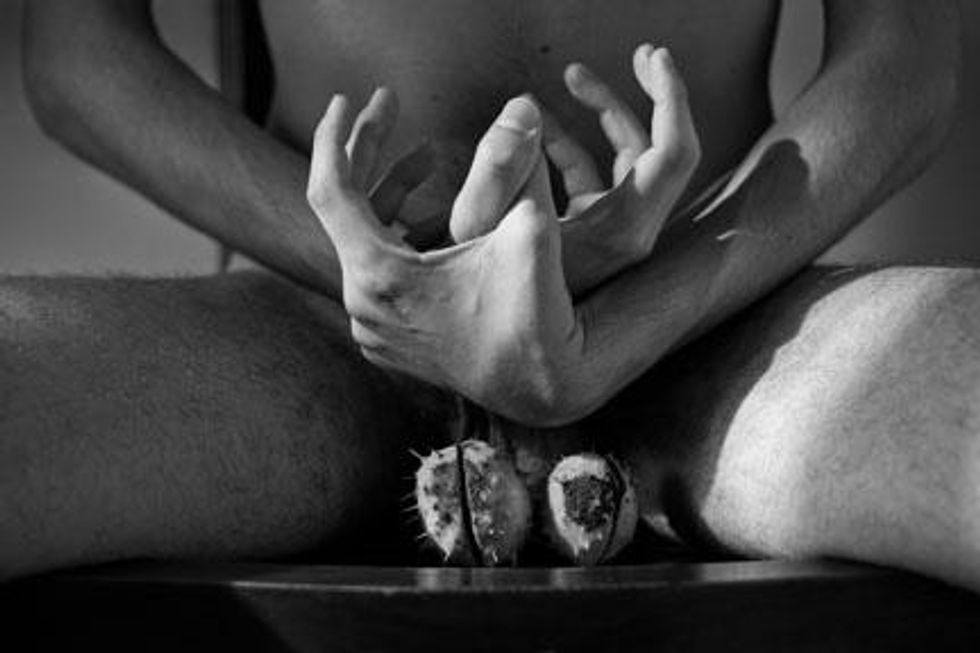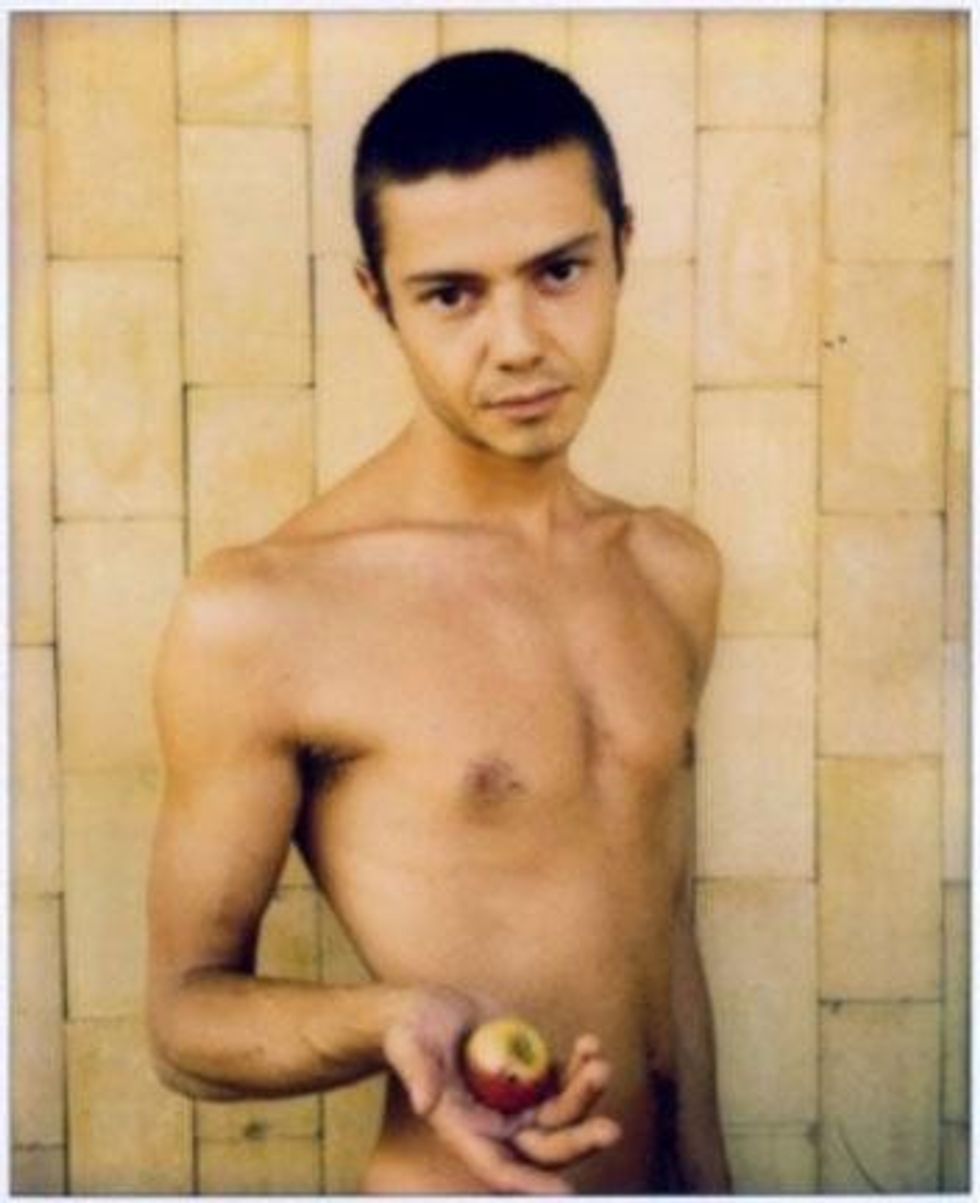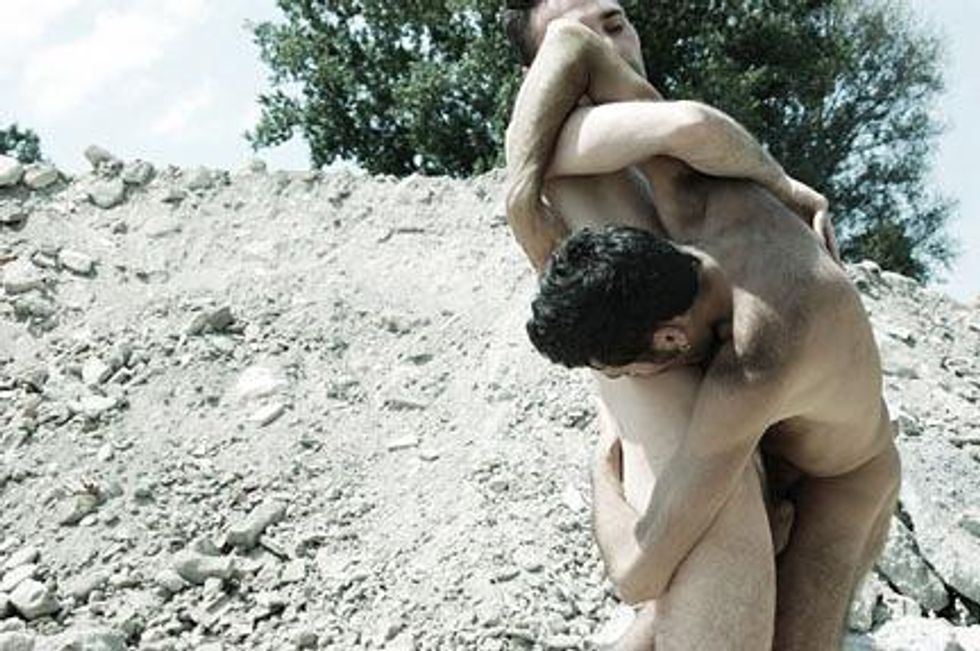Italy evokes distinct references for each person. Whether it's Michelangelo's David or the sensuality of Caravaggio's paintings, there's more to Italian art than the Reniassance master. And the current exhibition at the Leslie-Lohman Museum, titled Diaries: An Anthology of Photography from Italy (on view through February 3), proves that gay male photographers remain fascinated by the male form.
Curated by Peter Weiermair, the exhibit includes 11 artists that include references to the queer canon--including Pasolini, Jarman, Genet, Mapplethorpe--as well as clear Baroque, Renaissance, and classical antecedents. Although all the work is intensely personal, as the wall text at the beginning of the exhibit explains, "Diaries are a window between the inner and outer worlds. Among these images we can each find at least one page from our own diary."
While some may be well-known to those in the fashion industry, such as Gianfranco Maria Lelj (pictured at top left) who is renowned for his work with Vogue as well as portraits of Sophia Lauren and collaborations with Fellini, this is the first time his "gay" work has been on display in New York City. "He's now coming out about this work," Weiermair explains. "For a long time, he didn't publish his male nudes."
SLIDESHOW: See a Selection of Images Included in 'Diaries'
 The oldest of the artists represented, the niche where the Lelj photographs are displayed is adjacent to the youngest artist included in the show, Daniele de Vitis, whose personal portraits (pictured at right) involve the use of his own body in tableaus that capture a performative aspect and don't shy away from including his family and personal memories.
The oldest of the artists represented, the niche where the Lelj photographs are displayed is adjacent to the youngest artist included in the show, Daniele de Vitis, whose personal portraits (pictured at right) involve the use of his own body in tableaus that capture a performative aspect and don't shy away from including his family and personal memories.
"I concentrate on the use of the body as an object," de Vitis explains. "Working with the body is not working with beauty, it's a primitive thing to remind myself where I come from. I'm using my body as a performance, using it as a symbolic and metaphoric thing. When you do an exhibition with male bodies, people think about sexuality or nudity. It's an easy way of thinking, it's a direct connection with this thing--specially in Italy. You risk, you always risk. But it's not about sexual things or sexuality."
 The focus of this exhibit--all men, all male bodies--may seem passe to many at this point--especially with someone like Matthias Herrmann, well-known to many New Yorkers, and only tangentially an "Italian artist"--but the fact that an exhibit of this nature would be prohibited in Italy, according to all those interviewed for this story, due to the country's its neo-conservative movement and rigid social attitudes is why it remains provocative and essential.
The focus of this exhibit--all men, all male bodies--may seem passe to many at this point--especially with someone like Matthias Herrmann, well-known to many New Yorkers, and only tangentially an "Italian artist"--but the fact that an exhibit of this nature would be prohibited in Italy, according to all those interviewed for this story, due to the country's its neo-conservative movement and rigid social attitudes is why it remains provocative and essential.
Hunter O'Hanian, the museum's director, feels that the exhibit helps explore the way gay culture has been created in the United States and may be different outside its boundaries. "The way the male body looks like in the U.S. is one way; the exhibit shows that there's another way of looking outside of the United States," he says. "I think it's rare for any museum, to take two or three simple themes--gay culture, history, fine aesthetic culture--and put them together so that hopefully it transcends and relates to all human experience."
Two of the more experimental artists in the bunch attempt to do just that. Fabrizio Sacchetti (pictured above at left) uses his own body in reference to iconic Italian art, including the Baroque theme of Vanitas, or death. "It's a simple image transformed by performance," Sacchetti says. "The subject of beauty is very important: it might create comfort, but it might create discomfort." And his works, which show him at different ages during his life in a variety of contexts remain eerily urgent reminders of one's own mortality.

The Bologna artist who refers to himself as azt often uses his own body in his work as well (he's currently tattoing Genet's work on his body and has displayed it) and has created public installations and performances in various parts of Italy, but the photographs he currently has on display involve two models (strangers at the time of the shoot, pictured above) who engage in an erotic dance for apparent benefit of no one. The sense of discovery between them is palpable and challenges the viewer to become a voyeur of their playful, seductive combat, while remaining forcibly distant at the same time. With the erect penises and unadulterated sensuality on view, it reminds us how rare it is these days to see male beauty on display.
"The challenge is not to fall into pornographic standards," azt admits.
SLIDESHOW: See a Selection of Images Included in 'Diaries'




 The oldest of the artists represented, the niche where the
The oldest of the artists represented, the niche where the  The focus of this exhibit--all men, all male bodies--may seem passe to many at this point--especially with someone like Matthias Herrmann, well-known to many New Yorkers, and only tangentially an "Italian artist"--
The focus of this exhibit--all men, all male bodies--may seem passe to many at this point--especially with someone like Matthias Herrmann, well-known to many New Yorkers, and only tangentially an "Italian artist"--














































































